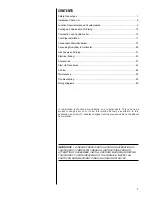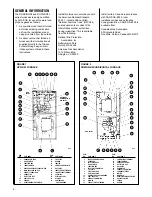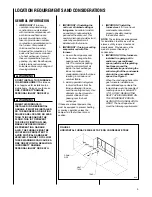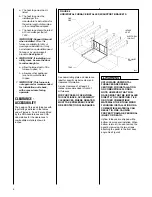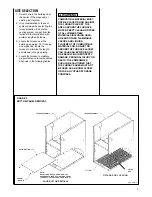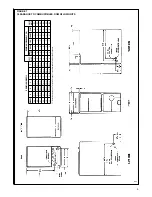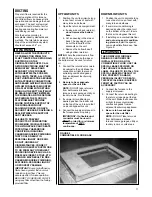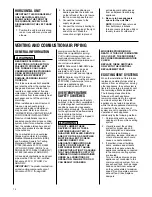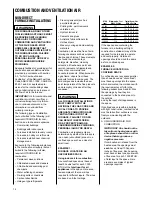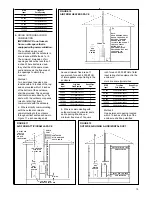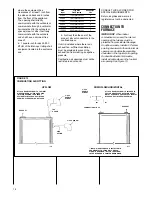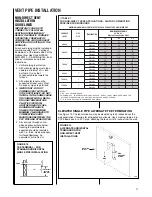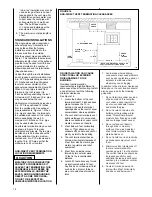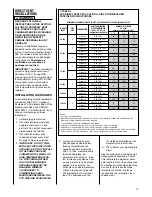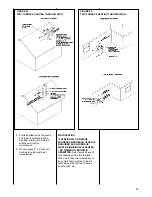
CEMENTING JOINTS
Properly seal all joints in the PVC
vent using the following materials and
procedures.
PVC CLEANER-PRIMER AND
PVC MEDIUM-BODY SOLVENT
CEMENT
IMPORTANT: After cutting pipe,
remove all ragged edges and burrs.
This is important to prevent reduction
in pressure drop throughout the
system.
1. Cut pipe end square. Chamfer
edge of pipe. Clean fitting socket
and pipe joint area of all dirt,
grease and moisture.
2. After checking pipe and socket
for proper fit, wipe socket and
pipe with cleaner-primer. Apply
a liberal coat of primer to inside
surface of socket and outside of
pipe. Read instructions included
with the primer for proper
application.
3. Apply a thin coat of cement
evenly in the socket. Quickly
apply a heavy coat of cement to
the pipe end and insert pipe into
fitting with a slight twisting
movement until it bottoms out.
NOTE: Cement must be fluid; if
not, recoat.
4. Hold the pipe in the fitting for 30
seconds to prevent the tapered
socket from pushing the pipe out
of the fitting.
5. Wipe all excess cement from the
joint with a rag. Allow 15 minutes
before handling. Cure time varies
according to fit, temperature and
humidity.
NOTE: Stir the solvent cement
frequently while using. Use a natural
bristle brush or the dauber supplied
with the can. The proper brush size is
one inch.
IMPORTANT: For Proper Installation
DO NOT use solvent cement that
has become curdled, lumpy or
thickened.
DO NOT thin. Observe shelf
precautions printed on containers.
For application below 32°F, use only
low-temperature-type solvent
cement.
13
4. Follow the lighting instructions.
Place the appliance being
inspected into operation. Adjust
the thermostat so the appliance
will operate continuously.
5. Test for spillage at the draft hood
relief opening after 5 minutes of
main burner operation. Use the
flame of a match or candle, or
smoke from a cigarette, cigar
or pipe.
6. After it has been determined that
each appliance that remains
connected to the common
venting system properly vents
(when tested as outlined above),
return doors, windows, exhaust
fans, fireplace dampers and any
other gas-burning appliance to
their previous conditions of use.
7. If improper venting is observed
during any of the above tests, the
common venting system must be
resized. Refer to latest edition of
the National Fuel Gas Code
ANSI Z223.1, 1992 or the AGA-
GAMA venting tables for
Category I furnaces.
When the furnace is installed in the
same space with other gas
appliances such as a water heater, be
sure there is an adequate supply of
combustion and ventilation air for the
other appliances. Do not delete or
reduce the combustion air supply
required by the other gas appliances
in this space. See Z223.1, National
Fuel Gas Code (NFPA54) or
CAN/CGA-B149.1 and .2 for deter-
mining the combustion air require-
ments for gas appliances. An
unconfined space must have at least
50 cubic feet (volume) for each
1,000 BTUH of the total input of all
appliances in the space. If the open
space containing the appliances is in
a building with tight construction
(contemporary construction), outside
air may still be required for the
appliances to burn and vent properly.
Outside air openings should be sized
the same as for a confined space.
JOINING PIPE AND
FITTINGS
PVC SOLVENT CEMENTS AND
PRIMERS ARE HIGHLY FLAM-
MABLE. PROVIDE ADEQUATE
VENTILATION AND DO NOT
ASSEMBLE NEAR HEAT SOURCE
OR AN OPEN FLAME. DO NOT
SMOKE. AVOID SKIN OR EYE
CONTACT. OBSERVE ALL
CAUTIONS AND WARNINGS
PRINTED ON MATERIAL CON-
TAINERS. FAILURE TO FOLLOW
THESE GUIDELINES MAY RESULT
IN FIRE, EXPLOSION OR
ASPHYXIATION CAUSING
PERSONAL INJURY OR DEATH.
All pipe, fittings, solvent cement,
primers and procedures must
conform to American National
Standard Institute and American
Society for Testing and Materials
(ANSI/ASTM) standards in the U.S.
Pipe and Fittings - ASTM-D1785,
D2466, D2665, D2231, D2661 and
F628.
PVC Primer and Solvent Cement -
ASTM-D2564
ABS Pipe and Fittings - Use ABS
Primer and Solvent Cement D2235
Procedure for Cementing Joints -
ASTM-D2855
IMPORTANT: The plastic combustion
air and venting components are of
PVC. If using ABS piping, ensure that
the solvent cement is compatible for
joining PVC to ABS components or
use a mechanical connection that can
withstand the vent temperatures and
are corrosion resistant.
!
WARNING
Summary of Contents for RGRA SERIES
Page 62: ...62...
Page 63: ...63...
Page 64: ...64 Rheem Manufacturing Company Air Conditioning Division Fort Smith Arkansas CM 1197...



